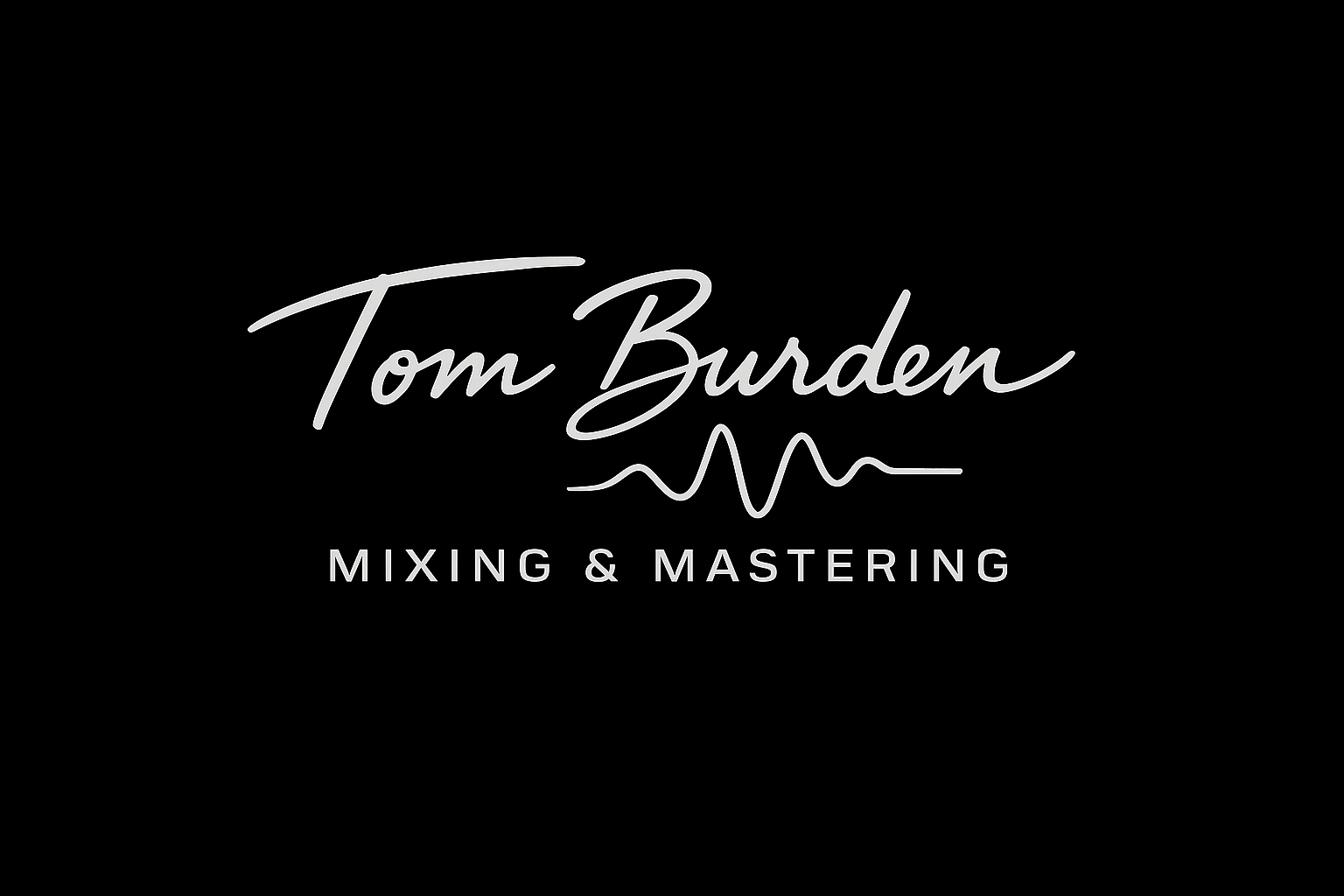About
Tom Burden discovered his calling at age seven, fingers dancing across piano keys in search of melodies that would shape his life's work. That early fascination with sound led him down two parallel paths: the artistry of performance and the precision of audio engineering.
From childhood experiments with cassette recorders to mastering guitar, bass, and synthesizer programming, Tom developed both the performer's intuition and the engineer's technical ear. This rare combination allows him to understand music from the inside out—how it feels to create and how it needs to sound.
Philosophy: Art First, Then Craft
Tom's approach is rooted in a simple belief: the music comes first. Every session begins with your artistic vision, then applies meticulous engineering to bring that vision to life. Whether you're crafting intimate folk ballads or driving electronic anthems, Tom works across all genres with the same commitment to excellence.
Beyond Mixing and Mastering
This isn't just technical service—it's a creative partnership. Tom offers a boutique audio experience where every detail matters, every choice serves the song, and every project receives the focused attention it deserves.
Your music. Your vision. Elevated.
Spotify Playlist
Resources for Musicians
Unlock your track's full potential—start with the best practices and creative tools:
🎹 JAXsynth
Custom synth tools & unique sound design playground for electronic producers.
Explore JAXsynth →🎵 Bedroom Producers Blog
Comprehensive resource for independent producers with free samples, tutorials, and gear reviews.
Explore Resources →Pre-Mix Essentials
- Export all stems from the exact same timeline position (usually bar 1, beat 1)
- Maintain consistent sample rate and bit depth across all files
- Include 2-4 bars of silence before the song starts for natural reverb tails
- Bounce full-length stems—don't truncate early, let reverbs and delays ring out
- Create a rough mix as a creative reference (but don't over-process it)
- Document your BPM, key signature, and any tempo changes
Technical Specifications
Optimal Export Settings
Track Naming & Organization
Drums
✓ Good: Kick_In, Kick_Out, Snare_Top, Snare_Btm, HiHat, Crash_L, Crash_R
✗ Bad: Audio_01, Track_15, Drumkit_Thing
Vocals
✓ Good: Lead_Vox, Harmony_1, Harmony_2, Vocal_Double, Backing_Vox
✗ Bad: Vocal, Voice_Track, Singer_Mic
Instruments
✓ Good: Bass_DI, Bass_Amp, Gtr_Rhythm_L, Gtr_Rhythm_R, Gtr_Lead
✗ Bad: Guitar_1, Instrument_02, Music_Part
Keys/Synths
✓ Good: Piano_Main, Synth_Lead, Synth_Pad, Organ_L, Organ_R
✗ Bad: Keyboard, Synth_Thing, MIDI_Track
Folder Structure Template
📁 [Artist Name] - [Song Title] ├── 📁 Stems_for_Mixing/ │ ├── 📁 Drums/ │ │ ├── Kick_In.wav │ │ ├── Kick_Out.wav │ │ ├── Snare_Top.wav │ │ └── HiHat.wav │ ├── 📁 Vocals/ │ │ ├── Lead_Vox.wav │ │ └── Harmony_1.wav │ ├── 📁 Guitars/ │ │ ├── Gtr_Rhythm_L.wav │ │ └── Gtr_Rhythm_R.wav │ └── 📁 Bass/ │ └── Bass_DI.wav ├── 📁 References/ │ ├── Rough_Mix.wav │ ├── Reference_Track_1.wav │ └── Reference_Track_2.wav ├── 📁 Project_Files/ │ └── [DAW_Project_File] └── 📄 Session_Notes.txt
What to Include in Your Session Notes
- Song key, BPM, and any tempo changes with timestamps
- Specific mix references that inspired your sound vision
- Any problem areas you're aware of (timing, pitch, noise)
- Special effects or processing you want to maintain
- The emotional story of the song and key moments
- Your target loudness level and intended streaming platforms
- Any instruments that should be featured or pushed back
- Deadline requirements and revision expectations
- Don't apply heavy limiting or brick-wall compression to your mix bus
- Avoid sending pre-fader stems (unless specifically requested)
- Don't normalize your stems—preserve the relative levels
- Never send zipped/compressed audio files for professional mixing
- Don't forget to include any automation data or MIDI information
Advanced Preparation Techniques
- Print effects sends (reverb, delay) as separate stems for more control
- Provide both processed and dry versions of key elements
- Include subgroup stems (all drums, all vocals, all guitars)
- Create alternate versions of questionable takes
- Bounce any software instruments to audio to avoid compatibility issues
- Include a stereo mixdown of your current mix for A/B comparison
🎹 JAXsynth
Custom synth tools & unique sound design playground for electronic producers.
Explore JAXsynth →🎵 Bedroom Producers Blog
Comprehensive resource for independent producers with free samples, tutorials, and gear reviews.
Explore Resources →🎤 Room & Acoustics
Your room matters more than your gear. Find the spot where your mix sounds balanced from multiple listening positions. Bass traps in corners work better than foam everywhere.
🎸 Timing & Feel
Quantize to 85-95% to keep human groove. Record multiple takes and comp the best parts. Use reference tracks to match the rhythmic feel you're after.
🎹 Arrangement Strategy
Give each instrument its own frequency space during arrangement, not mixing. If two parts compete for the same sonic area, change one's octave or tone instead of fighting with EQ later.
🎵 Smart Mic Placement
Close mics for intimacy, distant mics for room sound. Try the 3:1 rule—if one mic is 1 foot away, place the next at 3 feet to avoid phase issues. Experiment with stereo techniques like XY positioning.
🎧 Recording Levels
Keep 18-20dB of headroom throughout your chain. Record peaks around -12dB to -6dB. Your signal should be well above the noise floor but never hitting 0dB. Trust your ears over meters.
🎛️ Clean Signal Path
Keep your signal chain simple and use quality cables. A great performance through basic gear beats a poor performance through expensive equipment. Less conversion = cleaner sound.
🎨 Color Theory for Music
Just like visual artists use color palettes, try creating "sonic palettes" using specific instruments, effects, or tonal qualities that define your track's mood.
🌊 The Golden Ratio
Place your song's climax at approximately 61.8% through the track. This natural mathematical proportion creates satisfying musical tension and release.
🎭 Emotional Mapping
Before recording, write down 3-5 emotions you want listeners to feel. Let these guide every creative decision from chord progressions to mix choices.
🎪 Constraint Creativity
Try the "3-instrument rule" - force yourself to make a full track using only 3 sound sources. Limitations often spark the most creative solutions.
🎵 Microtonal Tuning
Explore beyond the 12-tone equal temperament system. Use 19-tone, 31-tone, or just intonation to create unique harmonic textures and emotional colors unavailable in standard tuning.

CEO of Music Label The VCG


(a.k.a. Nateharn)
